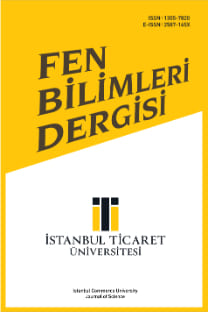AYDINLATMA SİSTEMLERİNİN YENİLENME GEREKSİNİMLERİ
Aydınlatma, Yenileme, Konfor şartları, Enerji etkinliği, Retrofit
RENEWAL REQUIREMENTS OF LIGHTING SYSTEMS
Lighting, Renewal, User comfort, Energy-efficiency, Retrofitting,
___
- Albrice, D. (2015). How Long Do Buildings Last. https://thecondogroup.com/long-buildings-last-david-albrice/ adresinden 06 Aralık 2022 tarihinde alınmıştır.
- Avrupa Komisyonu (2011). Restriction of Hazardous Substances in Electrical and Electronic Equipment (RoHS). https://environment.ec.europa.eu/topics/waste-and-recycling/rohs-directive_en adresinden 06 Aralık 2022 tarihinde alınmıştır.
- CEN/TR 15193-2:2017 (2017). Binalardaki enerji performansı – Aydınlatma ile ilgili enerji gerekleri – Bölüm 2: EN 15193-1 Modül M9, Türk Standartları Enstitüsü, Ankara.
- Global Alliance for Buildings and Construction (2020). 2020 Global Status Report for Buidings and Construction. https://globalabc.org/sites/default/files/inline-files/2020%20Buildings% 20GSR_FULL%20REPORT.pdf adresinden 06 Aralık 2022 tarihinde alınmıştır.
- Halonen, L., Tetri, E. & Bhusal, P. (edt.) (2010). Annex 45 Guidebook On Energy Efficient Electric Lighting For Buildings. Aalto Universitesi, Aalto.
- Hegger, M., Fuchs, M., Stark, T. & Zeumer, M. (2008). Energy Manual: Sustainable Architecture. Birkhauser Verlag AG, Basel.
- IEA (2021). Global lighting sales, historical and in the Net-Zero Scenario, 2010-2030, IEA, Paris https://www.iea.org/data-and-statistics/charts/global-lighting-sales-historical-and-in-the-net-zero-scenario-2010-2030 adresinden 6 Aralık 2022 tarihinde alınmıştır.
- İncedayı, D. (2007). Sürdürülebilirliğin kültürel boyutu, dosya 05 -sürdürülebilirlik: Kent ve mimarlık, Mimarlar Odası Ankara Şubesi Bülteni, no:51.
- İnşaat Teknolojileri Araştırma Grubu (1995). Enerji Etkin Konut ve Yerleşme Tasarımı, Proje No: İNTAG 201. TUBİTAK, Ankara.
- Karakaya, E. & Özçağ M. (2003). Türkiye Açısından Kyoto Protokolü’nün Değerlendirilmesi Ve Ayrıştırma (Decomposition) Yöntemi ile CO2 Emisyonu Belirleyicilerinin Analizi, VII. ODTÜ Ekonomi Konferansı, Ankara.
- Kitsinelis, S. & Kitsinelis S. (2015). Light Sources: Basics of Lighting Technologies and Applications, Routledge, United Kingdom.
- Kunduracı, A.C., Kazanasmaz, T. (2016). Aydınlatma kontrol sistemlerinin kullanıcı memnuniyeti üzerindeki etkisine eleştirel bir bakış, Celal Bayar Üniversitesi Fen Bilimleri Dergisi, 12(3), 553-560.
- Lam, J. C., Tsang, C.L. & Yang, L. (2006). Impacts of lighting density on heating and cooling loads in different climates in China, Energy Conversion and Management, 47(13-14), 1942-1953.
- Lohse, R., Staller, H. & Riel M. (2016). The economic challenges of deep energy renovation - differences, similarities, and possible solutions in central europe: Austria and Germany. ASHRAE Transactions, 122(1), 69-87.
- Maldonado, L., Hidalgo, A. & Hechavarria R. (2018). Greenhouse gas emission reduction by the selection of efficient lighting systems, IOP Conf. Series: Earth and Environmental Science, 188.
- Martin, L., Hauret, L. & Fuhrer, C. (2022). Digitally transformed home office impacts on job satisfaction, job stress and job productivity. COVID-19 findings. PLOS ONE 17(3), e0265131.
- Norden, J., Karlsson, H., Markusson, C., Ruud S., Lindgren, M. & Ollas, P. (2015). Changing to energy efficient light sources - an analysis of the energy balance of buildings, 6th International Building Physics Conference, Italy.
- Özçuhadar, T. (2007). Sürdürülebilir çevre için enerji etkin tasarımın yaşam döngüsü sürecinde incelenmesi [Yüksek lisans tezi]. İstanbul Teknik Üniversitesi Fen Bilimleri Enstitüsü, İstanbul.
- Özkaya, M. (1968). Aydınlatma tekniği, İtü Teknik Okulu Yayınları, İstanbul.
- Philips (2017). Fiyat listesi mayıs [Katalog]. Philips Aydınlatma, Hollanda.
- Philips (2008). Lighting catalog lamp specification and application guide 2008–2009 [Katalog]. Philips, Hollanda.
- Philips (2022). Ürün Kataloğu. https://www.lighting.philips.com.tr/prof adresinden 6 Aralık 2022 tarihinde alınmıştır.
- Sedziwy, A., Basiura, A. & Wojnicki, I. (2018). Roadway lighting retrofit: Environmental and economic impact of greenhouse gases footprint reduction, Sustainability, 10(11), 3925.
- Sirel, Ş. (2012). Aydınlatma sözlüğü, Yapı Fiziği Enstitüsü, İstanbul.
- Stiller, M. (2012). Quality lighting for high performance buildings, The Fairmont Press Inc. ABD.
- TS EN 12464-1:2021 (2021). Işık ve aydınlatma - Çalışma yerlerinin aydınlatılması - Bölüm 1: Kapalı çalışma alanları, Türk Standartları Enstitüsü, Ankara.
- TS EN 12665 (2019). Işık ve aydınlatma-Aydınlatma kurallarını belirleyen temel tarifler ve kriterler, Türk Standartları Enstitüsü, Ankara.
- Uyan, E., Küçükdoğu, M.Ş. & Aydemir, I. (2018). Aydınlatma Kalitesini Belirleyen Psikolojik Parametrelerin Çalışma Alanı Örneğinde İncelenmesi, İstanbul Ticaret Üniversitesi Fen Bilimleri Dergisi, 17(33), 51-60.
- Welz, T., Hischier, R. & Hilty L.M. (2011). Environmental Impacts of Lighting Technologies - Life Cycle Assessment And Sensitivity Analysis, Environ Impact Asses Rev., 31(3), 334-343.
- Williams, A., Atkinson, B., Garbesi, K., Page, E. & Rubinstein, F. (2012). Lighting controls in commercial buildings, The Journal of the Illuminating Engineering Society, 8(3), 161-180.
- 90.1-2019 (2019). Energy Standard for Buildings Except Low-Rise Residential Buildings, ANSI/ASHRAE/IES, ABD.
- ISSN: 1305-7820
- Yayın Aralığı: Yılda 2 Sayı
- Başlangıç: 2002
- Yayıncı: Doç. Dr. Necip Şimşek
ROBOTİK CERRAHİ UYGULAMALARININ İNCELENMESİ
Yavuz BASTUG, Osman YAZICIOĞLU, Oğuz BORAT
SIFIR GÜVEN AĞ ERİŞİM MİMARİSİNDE KULLANICI GÜVENLİĞİNİN SAĞLANMASI
Abbas BULUT, Muhammed Ali AYDIN, Abdül Halim ZAİM
İrem DUZDAR ARGUN, Senanur ÇELİK
ŞANS KISITLI VERİ ZARFLAMA ANALİZİ İLE ETKİNLİK ÖLÇÜMÜ: HAVALİMANI ÖRNEĞİ
İÇ MEKÂN TASARIMINDA RENK VE BİÇİMİN ETKİNLİĞİ
Leyla SURİ, Menekşe ŞEKER MURAT
ELEKTROMANYETİK KİRLİLİK ORTAMINDA KAOLİNİT/PVA KOMPOZİTLERİN ELEKTROMANYETİK KALKANLAMA ÖZELLİKLERİ
Ethem İlhan ŞAHİN, Mehriban EMEK
Seyit Ahmet SİS, Fatih ÜSTÜNER
ÜRETİM PLANLAMADA BULANIK DOĞRUSAL PROGRAMLAMA YÖNTEMİ: METAL SEKTÖRÜNDE BİR UYGULAMA
Dilara ÖZÜLKÜ, Sibkat KAÇTIOĞLU
TOPLU ULAŞIMDA YENİLİKÇİ GARAJ İŞLETTİRME MODELİ İÇİN ELEKTRİKLİ OTOBÜS KONSEPTİ
